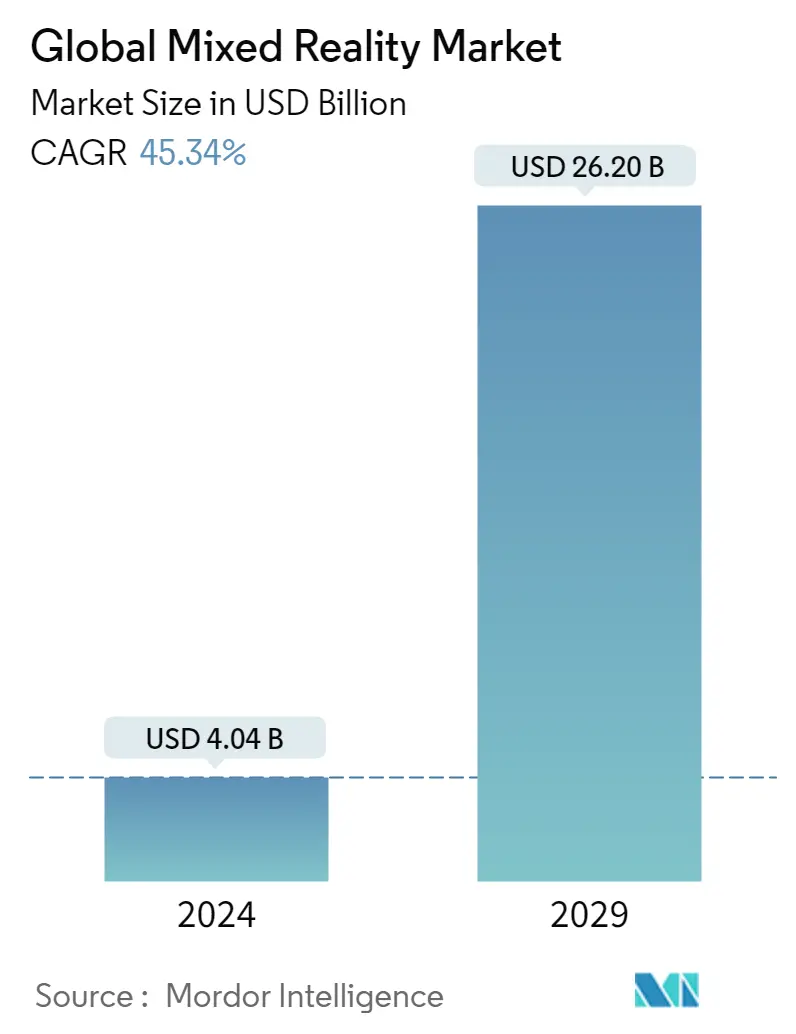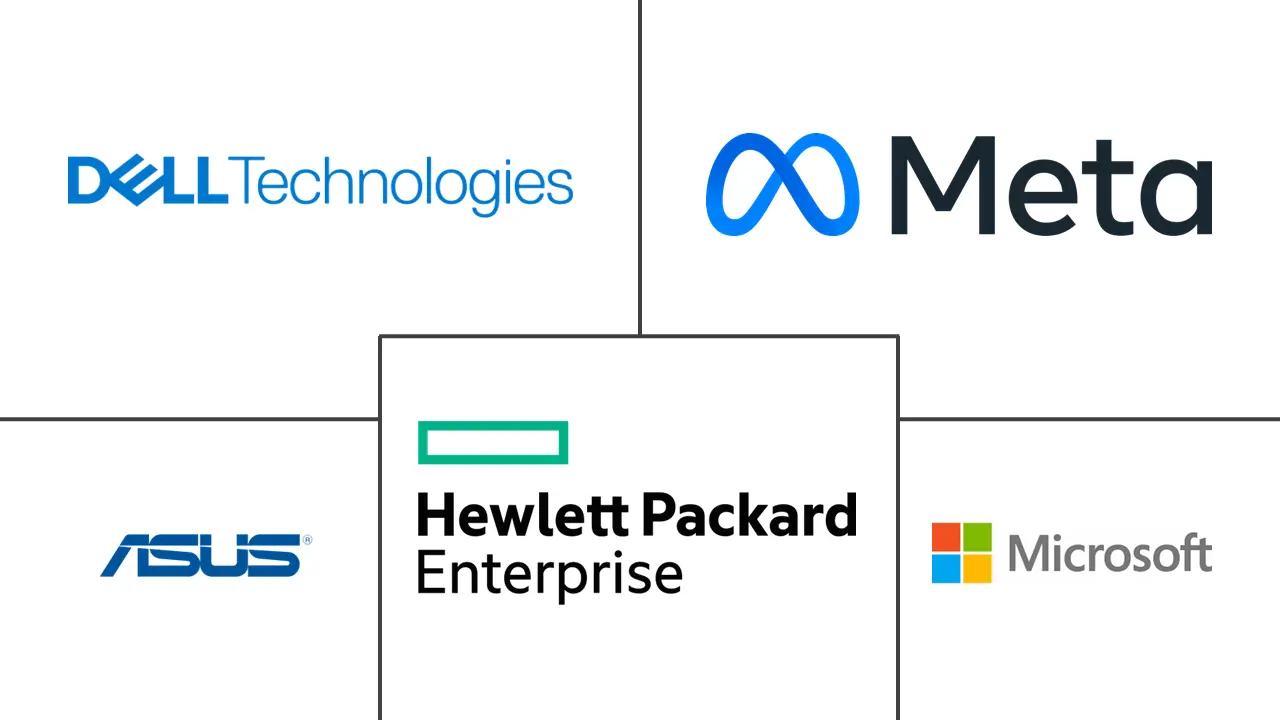| Study Period | 2019 - 2029 |
| Market Size (2024) | USD 4.04 Billion |
| Market Size (2029) | USD 26.20 Billion |
| CAGR (2024 - 2029) | 45.34 % |
| Fastest Growing Market | Asia Pacific |
| Largest Market | North America |
| Market Concentration | Low |
Major Players*Disclaimer: Major Players sorted in no particular order |
Mixed Reality Market Analysis
The Global Mixed Reality Market size is estimated at USD 4.04 billion in 2024, and is expected to reach USD 26.20 billion by 2029, growing at a CAGR of 45.34% during the forecast period (2024-2029).
Mixed reality (MR) is becoming increasingly well-known in business processes, and this trend is only anticipated to continue. Initial costs, though, have been at higher price points, making it difficult for consumers to afford them, but they are still rather cheap for businesses. By overlaying information on top of the real environment, MR devices can significantly boost people's knowledge of their surroundings for businesses. Allowing distant workers to see the work accurately in real-time so they can give greater input can enhance teamwork. Successful MR material for the entertainment industry needs to elicit an emotional response from the viewer.
- The increasing usage of mixed reality technologies in the global educational sectors is one of the primary factors driving the expansion of the mixed reality market share. Because it enables us to make things more interactive, the technology developed by the mixed reality industry is advantageous for both students and teachers. Additionally, it can be used by instructors to teach different students without requiring the importance of being at a specific location. Additionally, the mixed reality industry ensures that study methods improve and become more engaging. Additionally, using a variety of 3D images helps to reduce learning mistakes. This novel approach fuels the growing demand for mixed reality devices made by the education sector.
- The Food and Drug Administration (FDA) has approved multiple surgical planning apps for Microsoft's Hololens mixed reality headset. Companies, such as Gaumard, collaborated with Microsoft for the future of simulation-enhanced healthcare learning. In May 2021, A new mixed reality (MR) training program called "Obstetric MR" for "VICTORIA" was unveiled by Gaumard Scientific Co. Its goal is to support students to become clinically competent in delivery procedures more quickly and effectively. The Obstetric MR system comprises a HoloLens 2 device preloaded with new software for the VICTORIA S2200 maternal and neonatal care model patient, packed full of sensors and is used as a childbirth training tool for medical schools, nursing schools, and hospitals worldwide.
- Adopting mixed reality is picking up steam in several industries where having information at eye level is an advantage. Microsoft is increasingly emphasizing improving its products to broaden the scope of its application space. For instance, in March 2021, Microsoft was awarded a USD 21.9 billion contract by the US Army to manufacture HoloLens 2 headgear. Such improvements are also anticipated to impact how other end-user sectors adopt the technology.
- Physical lockdowns across the major regions may act positively on the MR technology demand. Enterprises worldwide are trying to get their internal and wider geographically spread teams to communicate, collaborate, and find a path forward during the crisis. The diverse potential of XR application in recreating the tourism experience allows multi-stakeholders to overcome the travel restrictions and lockdown, allowing the crisis to act as an accelerator of the existing trends for XR adoption. Medical professionals using mixed reality headsets to treat coronavirus-infected patients. Using hand gestures, clinicians using Microsoft devices can speak with coworkers in a separate, virus-free room while viewing x-rays, scans, and test results. The requirement for PPE has decreased due to technology.
- Mixed reality devices are also prone to risks since all the IoT devices interact with the Internet (i.e., the Internet is an unsecured network). The vulnerabilities exploited can be defined as risks. Moreover, preserving the data's confidentiality, integrity, and availability are data security and privacy concerns. In each state, this data could get vulnerable to cyberattacks. These cyberattacks could take a mode of computer-aided attack or a computer-targeted attack. Considering the risks of mixed reality systems requires analyzing them from two perspectives; the perspective of IoT architecture and the MR system.
Mixed Reality Industry Segmentation
Mixed reality combines the aspects of the virtual world with those of the real world. It enables users to interact with two worlds. The scope of the study focuses on a global market analysis of Mixed reality products. Market sizing encompasses the revenue generated through mixed reality products across the globe sold by various market players. The study also tracks the key market parameters, underlying growth influencers, and major vendors operating in the industry, which supports the market estimations and growth rates over the forecast period. The study further analyzes the overall impact of Covid-19 on the ecosystem. The report's scope encompasses market sizing and forecast for end-user verticals and geography.
The Global Mixed Reality Market is segmented by End-user Verticals (Education, Engineering, Entertainment, Healthcare) and by Geography.
| Education |
| Engineering |
| Entertainment |
| Healthcare |
| Other End-user Verticals |
| North America | United States |
| Canada | |
| Europe | United Kingdom |
| France | |
| Rest of Europe | |
| Asia-Pacific | China |
| India | |
| Japan | |
| Rest of Asia-Pacific | |
| Rest of the World |
Global Mixed Reality Market Size Summary
The mixed reality market is experiencing significant growth, driven by its increasing adoption across various sectors such as education, healthcare, and defense. This technology, which blends real and virtual environments, is becoming more prevalent in business processes, enhancing collaboration and knowledge sharing. Despite initial high costs, mixed reality devices are becoming more accessible to businesses, offering substantial benefits in terms of improved teamwork and engagement. The education sector, in particular, is leveraging mixed reality to create interactive and immersive learning experiences, which are proving to be more engaging and effective for students. This trend is further supported by partnerships and innovations in the field, such as Microsoft's collaborations with educational institutions and healthcare providers to integrate mixed reality into their training and educational programs.
The North American region is a key player in the mixed reality market, with significant investments in product innovations and strategic partnerships. Companies like Microsoft and CAE Inc. are at the forefront, developing solutions for both industrial and military applications. The market is moderately consolidated, with major companies continuously investing in strategic partnerships and product developments to expand their market share. Recent developments include collaborations between tech giants and educational institutions to enhance remote healthcare capabilities and educational possibilities. As the demand for mixed reality solutions grows, particularly in response to global challenges like the COVID-19 pandemic, the market is poised for substantial expansion, with a focus on improving communication, collaboration, and training across various industries.
Global Mixed Reality Market Size - Table of Contents
1. MARKET DYNAMICS
-
1.1 Market Drivers
- 1.1.1 High End-Electronic Consumer Market
- 1.1.2 Growing Adoption in Various Industries
- 1.1.3 Growing Awarness of Technology, along with Content Availability
- 1.2 Market Restrains
2. MARKET SEGMENTATION
-
2.1 End-user Verticals
- 2.1.1 Education
- 2.1.2 Engineering
- 2.1.3 Entertainment
- 2.1.4 Healthcare
- 2.1.5 Other End-user Verticals
-
2.2 Geography
- 2.2.1 North America
- 2.2.1.1 United States
- 2.2.1.2 Canada
- 2.2.2 Europe
- 2.2.2.1 United Kingdom
- 2.2.2.2 France
- 2.2.2.3 Rest of Europe
- 2.2.3 Asia-Pacific
- 2.2.3.1 China
- 2.2.3.2 India
- 2.2.3.3 Japan
- 2.2.3.4 Rest of Asia-Pacific
- 2.2.4 Rest of the World
Mixed Reality Market Research FAQs
How big is the Global Mixed Reality Market?
The Global Mixed Reality Market size is expected to reach USD 5.87 billion in 2025 and grow at a CAGR of 45.34% to reach USD 38.08 billion by 2030.
What is the current Global Mixed Reality Market size?
In 2025, the Global Mixed Reality Market size is expected to reach USD 5.87 billion.




